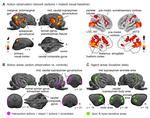Magdalena Boch
comparative social neuroscientist and psychologist
University of Vienna
University of Oxford
I am a postdoctoral researcher working at the Social Cognitive and Affective Neuroscience Unit at the University of Vienna and the Cognitive Neuroecology Lab at the University of Oxford. In my research, I use comparative functional neuroimaging to study a potential convergent evolution of the neural bases supporting social abilities in humans and dogs. I also combine multiple neuroimaging modalities to investigate the evolution, structure, and function of the temporal lobe — a key brain area for social cognition in primates— across a broad range of carnivoran species.
Download my CV.
- comparative neuroscience
- social cognition
- evolution of the social brain
- visual & multimodal perception
- non-invasive neuroimaging techniques
- open (neuro)science
-
PhD in Psychology (graded with honors), 2022
University of Vienna, AT
-
MSc in Psychology (graded with honors), 2017
University of Vienna, AT
-
BSc in Psychology, 2015
University of Vienna, AT













